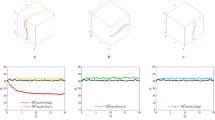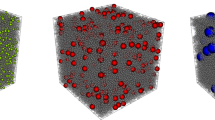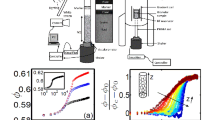Abstract
In this paper, we investigate the dependence of the viscosity of vibrated bidisperse granular suspensions of spherical particles on the relative fraction of the two populations. At the same total volume fraction ϕ, the viscosity of the bidisperse suspension is lower than that of a monodisperse suspension. A unified viscosity model is derived using an effective free volume approach based on the definition of an equivalent mean diameter and a maximum packing fraction, both depending on the fraction of large particles ξ. The resulting model accounts for the viscosity of the suspending fluid η f , the amplitude A, and the frequency f of the vibrations, for a constant ratio of the diameters of the beads λ = 5.3 and a fixed value of the total volume fraction ϕ ≈ 0.61. It led to a general equation describing both the rheology of monodisperse and bidisperse suspensions.






Similar content being viewed by others
Notes
The average granular pressure is defined by \(P_{g}={\Delta } \rho \phi g {\int }_{z_{0}}^{z_{0}+L} z \, \mathrm {d}z ={\Delta } \rho \phi g \frac {L+2 z_{0}}{2}={\Delta } \rho \phi g \bar {z}\) where L is the height of the vane, z 0 the distance between the free surface of the sample and the vane.
References
Biazzo I, Caltagirone F, Parisi G, Zamponi F (2009) Theory of amorphous packings of binary mixtures of hard spheres. Phys Rev Lett 102(19)195–701
Bournonville B, Coussot P, Chateau X (2004) Modification du modl̄e de farris pour la prise en compte des interactions géométriques d’un mélange polydisperse de particules. Rheologie 7:1
Boyer F, Guazzelli É, Pouliquen O (2011) Unifying suspension and granular rheology. Phys Rev Lett 107(18):188–301
Chang C, Powell RL (1993) Dynamic simulation of bimodal suspensions of hydrodynamically interacting spherical particles. J Fluid Mech 253:1–25
Chang C, Powell RL (1994) Effect of particle size distributions on the rheology of concentrated bimodal suspensions. J Rheol 38:85
Chong J, Christiansen E, Baer A (1971) Rheology of concentrated suspensions. J Appl Polym Sci 15(8):2007–2021
Clarke A, Wiley J (1987) Numerical simulation of the dense random packing of a binary mixture of hard spheres: amorphous metals. Phys Rev B 35(14):7350
Cohen MH, Turnbull D (1959) Molecular transport in liquids and glasses. J Chem Phys 31:1164
Coussot P, Ancey C (1999) Transition frictionnelle/visqueuse pour une suspension granulaire. CR Acad Sci II(327):515
D’Anna G, Gremaud G (2001) Vogel-fulcher-tammann–type diffusive slowdown in weakly perturbed granular media. Phys Rev Lett 87(25):254–302
Doolittle AK (1951) Studies in newtonian flow. ii. the dependence of the viscosity of liquids on free-space. J Appl Phys 22(12):1471–1475
Eveson G (1959) Rheology of disperse systems. Pergamon, London, England
Farr RS, Groot RD (2009) Close packing density of polydisperse hard spheres. J Chem Phys 131:244:104
Farris R (1968) Prediction of the viscosity of multimodal suspensions from unimodal viscosity data. J Rheol 12:281
Gondret P, Petit L (1997) Dynamic viscosity of macroscopic suspensions of bimodal sized solid spheres. J Rheol 41:1261
Hanotin C, De Richter SK, Marchal P, Michot LJ, Baravian C (2012) Vibration-induced liquefaction of granular suspensions. Phys Rev Lett 108(19):198–301
Hanotin C, Marchal P, Michot LJ, Baravian C, de Richter SK (2013) Dynamics of vibrated granular suspensions probed by mechanical spectroscopy and diffusing wave spectroscopy measurements. Soft Matter 9(39):9352–9360
He D, Ekere NN (2001) Viscosity of concentrated noncolloidal bidisperse suspensions. Rheol Acta 40(6):591–598
Huang N, Ovarlez G, Bertrand F, Rodts S, Coussot P, Bonn D (2005) Flow of wet granular materials. Phys Rev Lett 94(2):028–301
Krieger IM, Dougherty TJ (1959) A mechanism for non-newtonian flow in suspensions of rigid spheres. Trans Soc Rheol 3(1):137–152
Logos C, Nguyen Q (1996) Effect of particle size on the flow properties of a south australian coal-water slurry. Powder Technol 88(1):55–58
Macedo P, Litovitz T (1965) On the relative roles of free volume and activation energy in the viscosity of liquids. J Chem Phys 42:245
Marchal P, Choplin L, Smirani N (2009) Rheology of dense-phase vibrated powders and molecular analogies. J Rheol 53:1
Marchal P, Hanotin C, Michot LJ, de Richter SK (2013) Two-state model to describe the rheological behavior of vibrated granular matter. Phys Rev E 88(1):012–207
Mayor P, D’Anna G, Barrat A, Loreto V (2005) Observing brownian motion and measuring temperatures in vibration-fluidized granular matter. New J Phys 7(1):28
McGeary R (1961) Mechanical packing of spherical particles. J Am Ceram Soc 44(10):513–522
Ouchiyama N, Tanaka T (1984) Porosity estimation for random packings of spherical particles. Ind Eng Chem Fundam 23(4):490–493
Ovarlez G, Bertrand F, Rodts S (2006) Local determination of the constitutive law of a dense suspension of noncolloidal particles through magnetic resonance imaging. J Rheol (1978-present) 50(3):259–292
Poslinski A, Ryan M, Gupta R, Seshadri S, Frechette F (1988) Rheological behavior of filled polymeric systems ii. the effect of a bimodal size distribution of particulates. J Rheol 32:751
Qi F, Tanner RI (2012) Random close packing and relative viscosity of multimodal suspensions. Rheol Acta 51(4):289–302
Quemada D (1977) Rheology of concentrated disperse systems and minimum energy dissipation principle. Rheol Acta 16:82
Quemada D (2006) Modélisation rhéologique structurelle. Dispersions concentrées et fluides complexes Lavoisier, France
Russel WB, Saville DA, Schowalter WR (1992) Colloidal dispersions. Cambridge University Press
Shapiro AP, Probstein RF (1992) Random packings of spheres and fluidity limits of monodisperse and bidisperse suspensions. Phys Rev Lett 68(9):1422
Shauly A, Wachs A, Nir A (1998) Shear-induced particle migration in a polydisperse concentrated suspension. J Rheol 42:1329
Storms R, Ramarao B, Weiland R (1990) Low shear rate viscosity of bimodally dispersed suspensions. Powder Technol 63(3):247–259
Sweeny KH, Geckler RD (1954) The rheology of suspensions. J Appl Phys 25(9):1135–1144
Toivakka MO, Eklund DE (1996) Prediction of suspension rheology through particle motion simulation. Tappi J 79(1):211–222
Williams ML, Landel RF, Ferry JD (1955) The temperature dependence of relaxation mechanisms in amorphous polymers and other glass-forming liquids. J Am Chem Soc 77(14):3701–3707
Author information
Authors and Affiliations
Corresponding author
Appendix
Appendix
We study the behavior of the viscosity of the bidisperse suspension in the regime σ > σ f . In that case, η does not depend on σ v (Fig. 3a) and increases with the fluid viscosity η f (Fig. 3b). Experiments carried out with different viscosities of the suspending fluid show that η is a linear function of η f . Figure 7 displays the evolution of the relative viscosity η r300 = η/η f for σ =300 Pa as a function of ξ. The evolution is similar to that observed for σ < σ f (Fig. 3c) with a significantly lowered viscosity of the bidisperse suspension compared to the monodisperse one. Numerous experimental works (Sweeny and Geckler 1954; Eveson 1959; Chong et al. 1971; Poslinski et al. 1988; Storms et al. 1990; Shapiro and Probstein 1992; Gondret and Petit 1997; Logos and Nguyen 1996) and numerical simulations (Chang and Powell 1993; 1994; He and Ekere 2001; Toivakka and Eklund 1996; Farr and Groot 2009; Biazzo et al. 2009; Clarke and Wiley 1987) have shown that under shear, laws used to describe the viscosity of monodisperse suspensions such as Krieger Dougherty relation could be extended to the case of bidisperse suspensions using a maximum packing fraction ϕ ∗ that evolves with the fraction of large particles ξ. In the same way, it is reasonable to extend Quemada (1977)’s law, used to describe the viscosity-concentration curve for monodisperse particles (Fig. 2 in Hanotin et al. (2012)), to the case of bidisperse particles by applying Shauly et al. (1998)’s relation (Eq. 9 and Fig. 4) to describe the evolution of ϕ ∗ with ξ. Figure 7 displays the result of such a treatment and reveals a good agreement between experimental data and Quemada’s law. The agreement is slightly less satisfactory in the range ξ =0.6–0.8, i.e., in the range of minimal viscosity. This may be due either to some inaccuracy in (Shauly et al. 1998)’s relation or in the choice of \(\phi ^{\ast }_{mono}\) in (Eq. 9). Still, these results show that in the high shear regime, suspension behaves as a homogeneous suspension of hard spheres, whether the particles are monodisperse or bidisperse.
Relative high shear viscosity (η r300 = η/η f ) with η the suspension viscosity and η f the fluid viscosity for σ =300 Pa as a function of the fraction of large particles (ξ), for bidisperse particles immersed in a fluid of viscosity η f = 68 and 165 mPa.s. The line represents the fit of the experimental data by Quemada (1977)’s law with ϕ ∗ determined by Shauly et al. (1998)’s relation (Eq. 9 and Fig. 4)
Rights and permissions
About this article
Cite this article
Hanotin, C., de Richter, S.K., Michot, L.J. et al. Rheological behavior of vibrated bimodal granular suspensions: a free volume approach. Rheol Acta 54, 327–335 (2015). https://doi.org/10.1007/s00397-014-0833-8
Received:
Revised:
Accepted:
Published:
Issue Date:
DOI: https://doi.org/10.1007/s00397-014-0833-8





